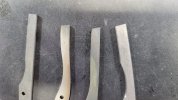The following is a step-by-step process to constrain the geometry of a slipjoint tang in CAD software. I used FreeCAD for this, but it should work similarly in other CAD packages. Full disclosure: I have never made a slipjoint and this is just an exercise in geometry that was prompted by a thread Sean Yaw posted a while ago. Since this came up again in a different thread, I thought I'd post a thread about it here. Please, let me know if you see anything wrong with it.
The first step is to create a spreadsheet with the parameters. The geometry will be constrained using the size, half-stop angle, open/closed angle and the kick length. The radius is computed by dividing the size by the square root of two.

The first step is to draw two lines from the pivot point. Note that I am using construction mode for the moment, as the lines will not be part of the actual tang.

The two lines now get the following constraints applied:
1. Their length is the radius
2. The angle between them is the half-stop angle
3. Their end points are on a horizontal line
The constraints result in the following geometry.

A third line from the pivot point is now added with the following constraints:
1. The length is the radius.
2. The angle between the new line and the second line is the half stop angle.

The next step is to connect the end points from the second and third line. The corner of the tang must be on this line.

Now, another line from the pivot is added with the following constraints:
1. The length is again the radius.
2. The angle between the first line and the new one is the opening angle

Again, a new line from the pivot has to be added, this time the constraints are
1. The length is the radius.
2. The angle between the line from the previous step and the new line is the half-stop angle, i.e., the angle between the new line and the first line is the half-stop angle plus the opening angle.

The end points of the two lines created in the previous two steps are now connected with another line.

Now, a point is added at the intersection of the last step and the line between the two end points (2 and 3) created earlier:

This point is the corner point of the tang, and the kick can be found along the direction of the last line that was added, at the specified kick distance. In the image below, the completed tang is shown in green lines, i.e., they are not in construction mode.

This construction method should give the correct tang geometry as long as the opening angle is less than twice the half stop angle, which should always be the case. The following three pictures illustrate how the tang and spring fit together in the three positions.



The first step is to create a spreadsheet with the parameters. The geometry will be constrained using the size, half-stop angle, open/closed angle and the kick length. The radius is computed by dividing the size by the square root of two.

The first step is to draw two lines from the pivot point. Note that I am using construction mode for the moment, as the lines will not be part of the actual tang.

The two lines now get the following constraints applied:
1. Their length is the radius
2. The angle between them is the half-stop angle
3. Their end points are on a horizontal line
The constraints result in the following geometry.

A third line from the pivot point is now added with the following constraints:
1. The length is the radius.
2. The angle between the new line and the second line is the half stop angle.

The next step is to connect the end points from the second and third line. The corner of the tang must be on this line.

Now, another line from the pivot is added with the following constraints:
1. The length is again the radius.
2. The angle between the first line and the new one is the opening angle

Again, a new line from the pivot has to be added, this time the constraints are
1. The length is the radius.
2. The angle between the line from the previous step and the new line is the half-stop angle, i.e., the angle between the new line and the first line is the half-stop angle plus the opening angle.

The end points of the two lines created in the previous two steps are now connected with another line.

Now, a point is added at the intersection of the last step and the line between the two end points (2 and 3) created earlier:

This point is the corner point of the tang, and the kick can be found along the direction of the last line that was added, at the specified kick distance. In the image below, the completed tang is shown in green lines, i.e., they are not in construction mode.

This construction method should give the correct tang geometry as long as the opening angle is less than twice the half stop angle, which should always be the case. The following three pictures illustrate how the tang and spring fit together in the three positions.


















